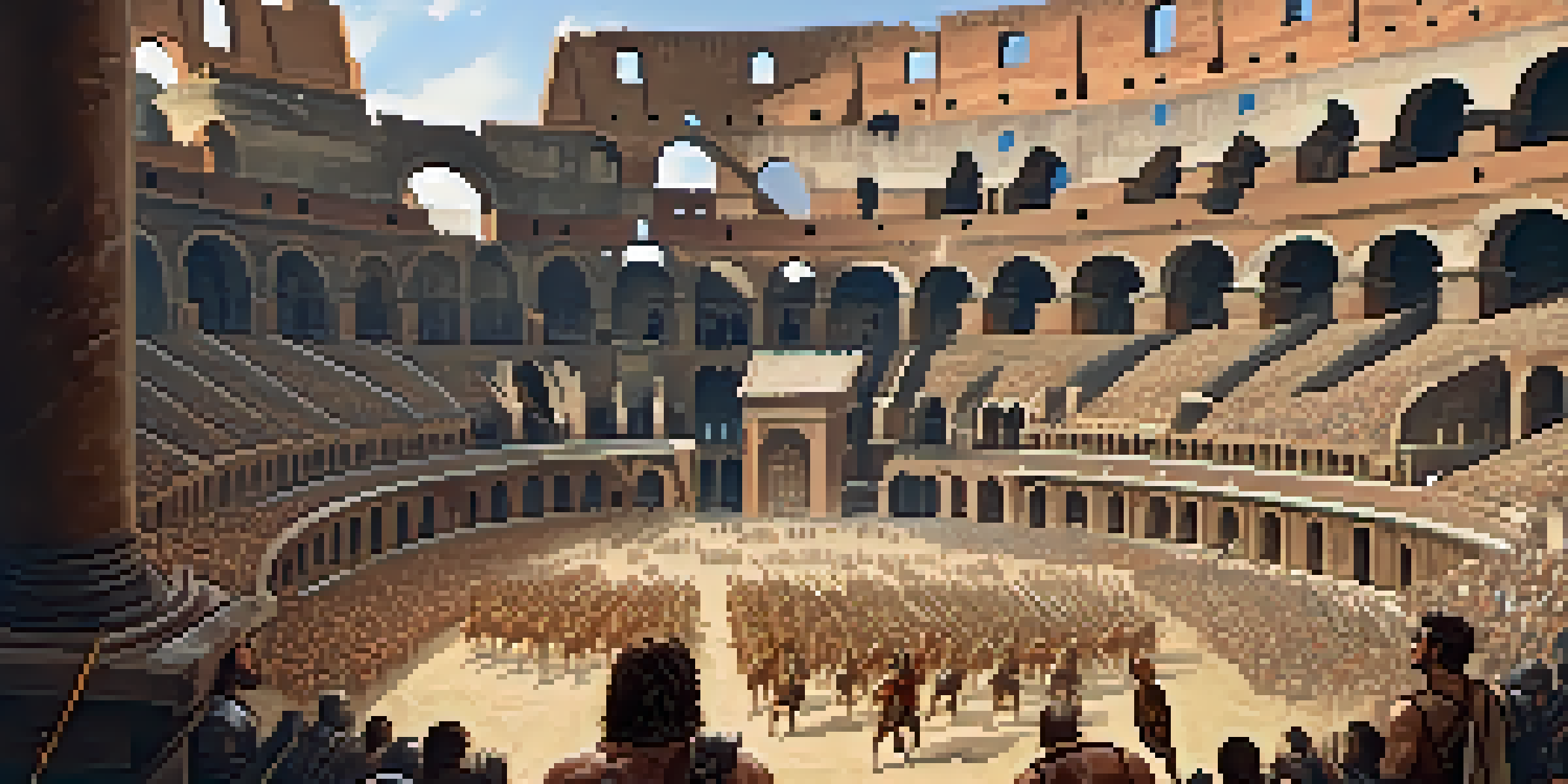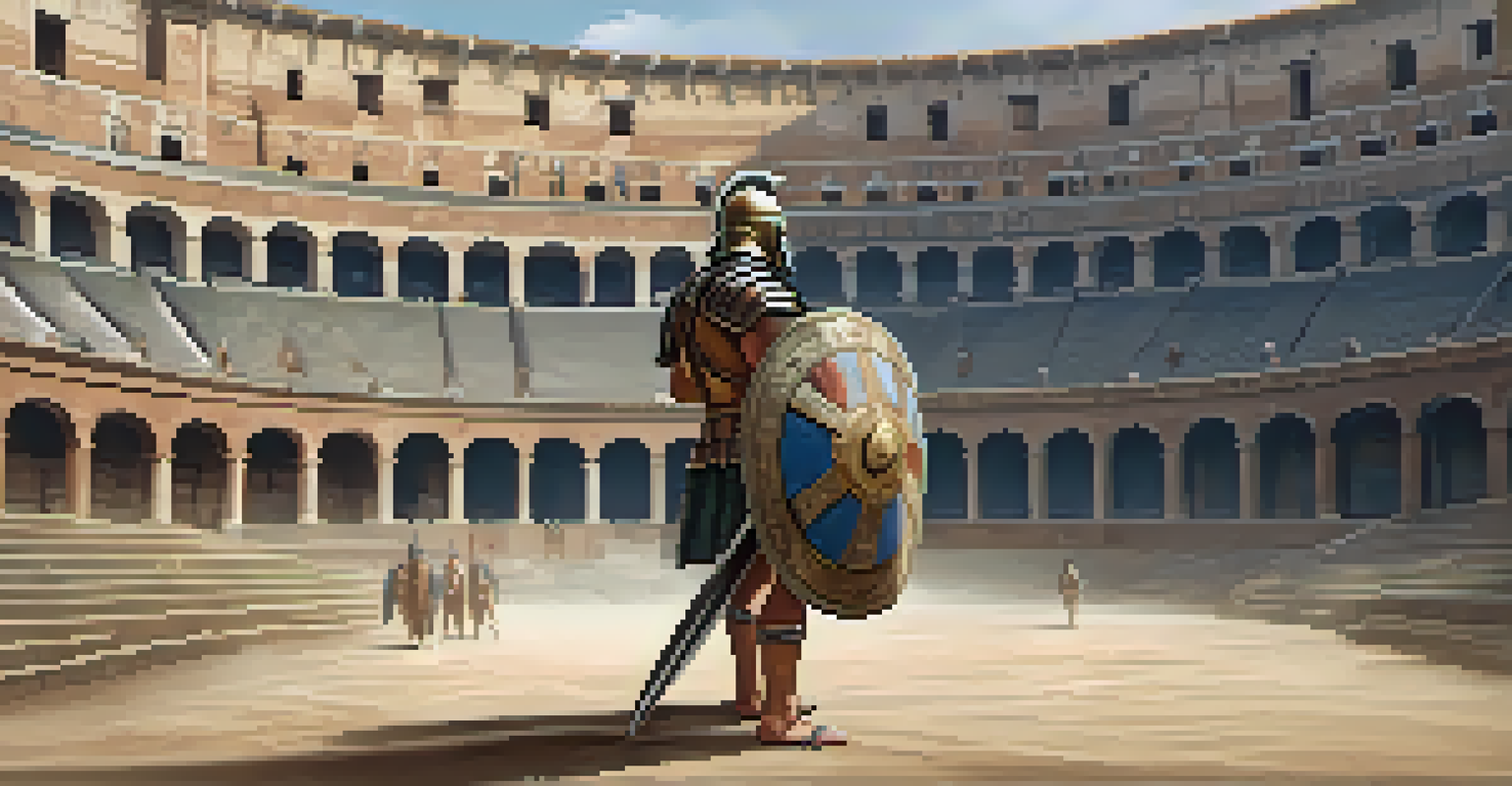The Gladiators: Combat Skills in Ancient Roman Warfare

Understanding the Gladiator's Role in Ancient Rome
Gladiators were not just fighters; they were a crucial part of Roman culture and entertainment. These skilled combatants often fought in arenas, captivating audiences with their bravery and prowess. While they were typically slaves or prisoners, some volunteered for the glory that came with being a gladiator, aiming for fame and fortune.
The gladiator's arena was a place where life and death danced a macabre waltz, captivating the hearts of the spectators.
The life of a gladiator was harsh, yet it offered a unique pathway to social mobility within the rigid structure of Roman society. Winning in the arena could lead to freedom, wealth, and even celebrity status. This allure drew many men, and sometimes women, into the brutal world of gladiatorial combat.
Ultimately, gladiators symbolized the complexities of Roman life, embodying both the brutality of warfare and the spectacle of entertainment. Their battles were a reflection of the societal values of the time, highlighting the Roman fascination with power, honor, and survival.
Types of Gladiators and Their Unique Skills
The world of gladiators was diverse, with various types trained for different combat styles. For instance, the 'Murmillo' wore a helmet with a fish crest and wielded a gladius, a short sword. On the other hand, the 'Thraex' was known for his agility and used a curved sword called a sica, which allowed for swift attacks.

Each type of gladiator had specialized training that honed their combat skills, making them formidable opponents in the arena. Training schools, known as 'ludi,' were where these fighters learned techniques, strategy, and discipline. Their training often mirrored that of professional soldiers, emphasizing the importance of skill in combat.
Gladiators: Fighters and Entertainers
Gladiators played a crucial role in Roman culture, serving not only as combatants but also as entertainers who captivated audiences with their bravery.
This variety not only made the fights more exciting for spectators but also highlighted the gladiators' adaptability and strategy. Different styles meant that each match could showcase a unique confrontation, showcasing the skill and prowess of these ancient warriors.
The Training Regimen of Gladiators
Gladiators underwent rigorous training to prepare for the challenges of the arena. Their daily routines included physical conditioning, combat drills, and learning techniques from experienced instructors. This intense preparation was crucial, as survival in the arena depended on their ability to outmaneuver and outsmart their opponents.
In the arena, glory is a double-edged sword; it can elevate a man to the heights of fame or plunge him into the depths of despair.
In addition to physical strength, gladiators were trained in tactics and strategy, learning how to read their opponents and exploit weaknesses. This emphasis on mental acuity set gladiators apart from mere fighters; they were warriors who understood the psychology of combat. The training process fostered a deep sense of camaraderie among gladiators, as they relied on each other for support and advice.
Ultimately, this thorough training regimen transformed ordinary individuals into skilled warriors capable of engaging in life-and-death battles. The discipline and dedication required to succeed in this brutal environment shaped the identity of gladiators as both skilled fighters and resilient individuals.
Combat Techniques Used by Gladiators
Gladiators employed various combat techniques, blending speed, strength, and strategy to gain the upper hand. Techniques such as feints and counters were crucial, allowing them to trick their opponents into making mistakes. By understanding their opponent's style and weaknesses, a gladiator could turn the tide of a battle in their favor.
Many gladiators also utilized specific maneuvers designed to disarm or incapacitate their foes quickly. For example, they might use a series of rapid strikes to overwhelm an opponent before executing a finishing move. This combination of agility and aggression made gladiatorial combat a thrilling spectacle for crowds in the Colosseum and other arenas.
Rigorous Training for Survival
The intense training regimen of gladiators transformed them into skilled warriors, emphasizing the importance of physical strength, tactics, and mental acuity.
The artistry of gladiatorial combat was not limited to brute force. The ability to read an opponent's intentions and respond accordingly was a skill that separated the great gladiators from the rest. This level of tactical thinking showcased the gladiators not just as fighters, but as master strategists in the heat of battle.
The Role of Weapons in Gladiatorial Combat
Weapons played a pivotal role in gladiatorial combat, with each type of gladiator wielding specific arms suited to their fighting style. From the short gladius to the long spear, the choice of weapon greatly influenced the dynamics of each fight. The design and weight of these weapons were crafted for both efficiency in combat and dramatic flair during performances.
In addition to traditional weapons, gladiators sometimes used shields and armor that provided protection while allowing mobility. The balance between offense and defense was a critical aspect of their training, as gladiators learned to adapt their tactics based on the weapons they were using. This adaptability was essential for survival in the unpredictable arena.
Ultimately, the variety and sophistication of weapons added depth to gladiatorial combat. Each weapon had its own advantages and disadvantages, requiring gladiators to be versatile and skilled in their use. This mastery over a range of arms not only showcased their talent but also captivated the audience, making each match a unique spectacle.
The Gladiatorial Arena: A Stage for Combat Skills
The arena was more than just a battleground; it was a grand stage where gladiators showcased their skills. Massive structures like the Colosseum in Rome provided a dramatic backdrop for these intense confrontations, drawing thousands of spectators eager to witness the action. The atmosphere was electric, as cheers and gasps filled the air with each clash of weapons.
Arena combat was not merely about survival; it was also about performance. Gladiators often incorporated showmanship into their fighting, using theatrics to engage the audience and elevate the spectacle. This blend of combat and entertainment added an extra layer of excitement, making the fights not just battles, but memorable events.
Enduring Legacy in Modern Culture
The legacy of gladiators continues to resonate today, influencing films and games while highlighting themes of courage and the complexities of human history.
The design of the arena itself played a crucial role in shaping the combat experience. Features like the sand-covered floor, which absorbed blood and provided traction, and the tiered seating that offered every spectator a good view, were all part of creating the perfect environment for gladiatorial displays. This focus on the experience turned the arena into an iconic symbol of Roman culture.
The Legacy of Gladiators in Modern Culture
The legacy of gladiators extends far beyond ancient Rome, influencing modern culture in various ways. From movies like 'Gladiator' to video games, the image of the gladiator as a fierce warrior continues to capture the imagination. These representations often romanticize the life of gladiators, focusing on themes of bravery, honor, and survival.
In addition to entertainment, the story of gladiators serves as a reminder of the complexities of human history. Their lives reflect the struggles and triumphs of individuals in a society that valued strength and spectacle. This duality fosters a deeper appreciation for the sacrifices these fighters made in pursuit of glory.

Ultimately, the enduring fascination with gladiators speaks to our collective love for stories of courage and resilience. As we explore their legacy, we gain insight into the human condition and the timeless battle between life and death, honor and defeat.